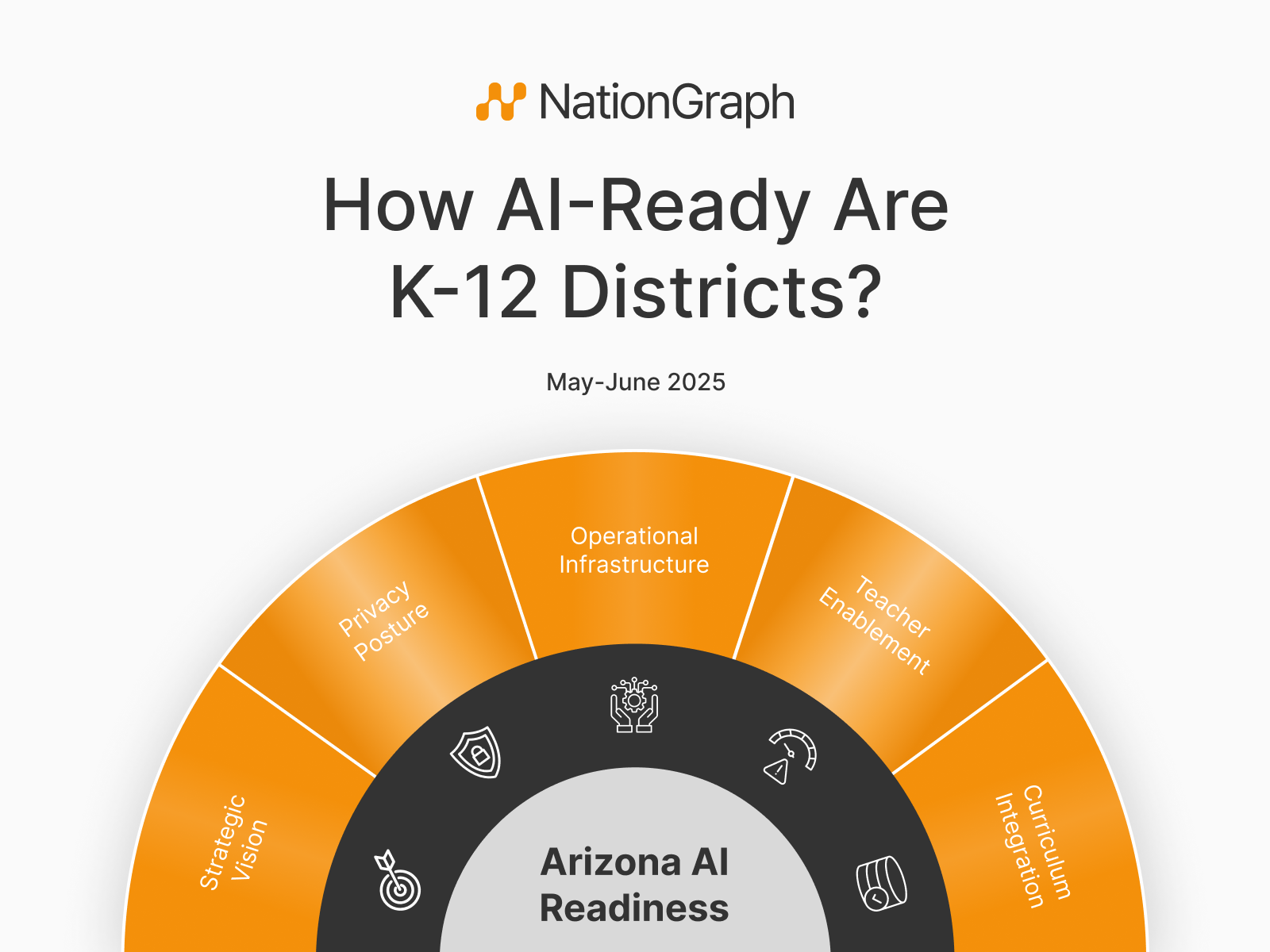K-12 Mental Health Technology Spending: $81.6M Market Analysis Of EdTech Opportunities
.png)
Which School Districts Spend Most on Mental Health Technology?
School districts across America are making significant strategic investments in mental health technology.
We analyzed comprehensive purchase order data from 875 mental health technology acquisitions across 50 high-spending school districts to uncover exactly where the money is flowing.
And more importantly, where it's heading next.
Annual Budget Increases Signal Market Expansion
Recent meeting minutes and budget analyses using NationGraph reveal districts are fundamentally reshaping their financial priorities around student mental health:
Broward County Public Schools (FL)
The district has formally committed new budget dollars to expand its on-campus mental-health staff, specifically targeting:
"Direct employment of school-based mental health service providers to reduce the ratio of students to staff to better align with nationally recommended ratio models."
More importantly for EdTech vendors, their strategic planning documents explicitly link these staffing increases with a tech-enabled service model, noting:
"Broward County is actively investing in mental health technology solutions to enhance service delivery within schools."
Adams 12 Five Star Schools (CO)
Adams represents large-scale district commitment, adding counselors and social workers across all school levels while developing comprehensive social-emotional learning curriculum. Their School Health Professional Grant (SHPG) specifically funds behavioral health education and intervention programs, with plans to increase behavioral and mental health classes in their Career and Technical Education programs.
Madison Metropolitan School District (WI)
Through its ARP-funded ESSER III grant, the district has earmarked funds specifically for bolstering mental-health supports:
"These awards have been crucial for MLPS in enhancing their mental health support systems and acquiring necessary technology for maintaining these initiatives."
What These Budget Increases Mean for EdTech Vendors
These budget reallocations signal three critical market shifts:
- Mental health is moving from supplemental to essential in district budgeting
- Multi-year strategic commitments are replacing one-time purchases
- Comprehensive solutions are getting funded over point tools
- Technology integration is explicitly planned alongside staffing increases
The Scale of K-12 Mental Health Technology Investment
The numbers of our analysis tell a story for EdTech sales teams:
- $81.6 million in verified mental health technology spending
- 663,569 students served by these programs
- 875 individual purchases tracked across solution categories
- $28 average per-student investment (with leading districts spending up to $979 per student)
- 300% year-over-year growth in telehealth platform adoptions
This reveals significant investment in mental health technology across key districts, with 25+ districts actively implementing telehealth platforms, crisis response systems, assessment tools, and learning management integration.
The Biggest Buyers: Where Mental Health EdTech Contracts Are Won
Hollidaysburg Area School District, Pennsylvania
%20(1024%20x%20200%20px)%20(2).png)
Hollidaysburg is pioneering the future of rural mental health tech, leading with a partnership-driven approach that blends staff training and technology integration to expand access in rural communities.
Key Intelligence for EdTech Vendors:
- 17 strategic purchases indicating focused procurement approach
- Multi-year comprehensive service agreements with proven vendors
- Technology integration specifically designed for rural access challenges
- Model district for rural mental health technology deployment strategies
Burbank Unified School District, California
%20(1024%20x%20200%20px)%20(3).png)
Burbank emphasizes culturally responsive services with bilingual support programs and community agency partnerships for comprehensive care.
Strategic Opportunity: Gateway to California's diverse district market with established partnership models and strong focus on bilingual mental health services.
Innovation Testing Ground: Berkeley Unified School District, California
%20(1024%20x%20200%20px)%20(4).png)
Berkeley demonstrates progressive mental health integration with social justice initiatives and technology pilot programs for innovative solution testing. If you want to pilot cutting-edge mental health EdTech, Berkeley is your launchpad.
Large-Scale Systematic Buyer: Fort Bend ISD, Texas
%20(1024%20x%20200%20px)%20(5).png)
Fort Bend ISD operates large-scale systematic service delivery with multi-vendor approach. With 88 mental health purchases, they've proven that systematic procurement at scale works—and they're the prototype for other large district implementations.
Technology Categories Driving K-12 Mental Health EdTech Growth
1. Telehealth & Virtual Therapy Platforms
35+ districts, $45K-$125K annually, 300% YoY growth
The pandemic accelerated telehealth adoption, but these investments are sticking. Districts are discovering that virtual therapy platforms solve rural access problems and provide consistent care regardless of staffing challenges.
2. Crisis Response Systems
28+ districts, $25K-$85K annually, 24/7 availability
School shootings and mental health crises have made 24/7 crisis response systems non-negotiable. Districts are investing heavily in platforms that integrate with local emergency services and provide immediate intervention capabilities.
3. Assessment & Screening Tools
42+ districts, $15K-$60K annually, early identification focus
Early identification drives better outcomes and lower costs. Districts are systematically implementing digital screening platforms that integrate with student information systems for seamless workflow.
Market Intelligence: Where EdTech Vendors Should Focus Next
High-Growth Investment Indicators
Three districts showing explosive growth patterns deserve immediate attention:
Fargo Public Schools, North Dakota: Investment: $716K | Students: 11,431 | 56 Purchases
- Crisis intervention and staff training focus with systematic evaluation approach
- Market Signal: Openness to new technology solutions through multiple platform evaluations
Hillsboro School District, Oregon: Investment: $455K | Students: 18,920 | 33 Purchases
- Technology-forward delivery systems with community integration model
- Market Signal: Progressive technology adoption in suburban setting
Donna ISD, Texas: Investment: $402K | Students: 13,165 | 26 Purchases
- Culturally responsive services for border district population
- Market Signal: High demand for bilingual mental health technology solutions
Grant Funding Creating Immediate Opportunities
Federal ESSER Funding: $2.1B nationally available with districts actively leveraging COVID recovery funds
State-Specific Opportunities:
- Pennsylvania: Rural health initiative funding
- California: $4.2B mental health funding over 5 years
- Texas: $1.8B safety and mental health initiatives
Technology Gaps Represent Million-Dollar Opportunities
1. Bilingual Mental Health Platforms
Exploding demand in Texas and California districts, but few comprehensive solutions exist. Donna ISD's focus on culturally responsive services for border district population represents high demand for bilingual mental health technology solutions.
2. Rural Access Solutions
Hollidaysburg's model for rural mental health technology deployment proves the concept works, but most platforms aren't designed for connectivity challenges.
3. Integration Capabilities
42+ districts investing in assessment and screening tools with early identification focus need platforms that seamlessly integrate with existing student information systems.
Procurement Timing Intelligence: When Districts Buy Mental Health Technology
Understanding procurement cycles can make the difference between winning and losing million-dollar contracts:
- July-August: New fiscal year contract renewals (high activity period)
- October-November: Mid-year supplemental funding decisions
- February-March: Next fiscal year planning and RFP releases
- April-May: Grant-funded procurement cycles
Immediate Action Items for Mental Health EdTech Vendors
Target High-Investment Districts
Prioritize outreach to the top 10 mega-investor districts ($1M+) focusing on expansion opportunities for existing successful programs. These represent proven buyers with established procurement processes.
Approach Grant-Funded Districts
Contact districts with active ESSER and state mental health funding, focusing on California's $4.2B initiative and Texas's $1.8B safety programs.
Engage Partnership-Based Districts
Prioritize districts with established community partnerships: Hollidaysburg (PA), Burbank (CA), and Berkeley (CA) for integration opportunities.
The Future of K-12 Mental Health Technology Procurement
Districts aren't buying point solutions anymore—they're architecting comprehensive mental health ecosystems. This analysis demonstrates that NationGraph effectively identifies forward-looking mental health EdTech opportunities before they manifest as competitive RFPs.
The data reveals three critical trends:
- Comprehensive Integration: Districts want platforms that work together, not standalone tools
- Cultural Responsiveness: Bilingual and culturally adapted solutions are becoming requirements, not nice-to-haves
- Outcome Measurement: ROI demonstration capabilities are increasingly determining contract awards
How NationGraph Turns Market Intelligence Into Revenue
This analysis represents just 50 of the 16,000+ school districts and charter schools in our comprehensive database. By focusing on districts with proven investment patterns, active grant funding, and strategic mental health initiatives, EdTech companies can position themselves to capture market share proactively.
What This Level of Intelligence Provides:
- Real-time purchase order monitoring across all districts
- Grant funding alerts for opportunity identification
- Comprehensive vendor ecosystem mapping for competitive intelligence
- Custom reporting and analysis for specific market focuses
The mental health EdTech market is exploding, but success requires precision targeting of proven buyers with validated spending patterns. The districts investing millions today are the reference customers that will drive tomorrow's market adoption.
Ready to access the full K-12 mental health technology market intelligence?
The next wave of EdTech contracts is already underway. Contact us and we’ll show you exactly how to spot and win them.



.png)

.png)